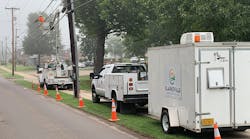Municipalities and utilities across rural America are embracing fiber as a technology "for the rest of us", providing numerous social and financial benefits to their communities. Politicians, small business owners, and ordinary townspeople, in these areas firmly believe that becoming part of the Gigabit Society is vital for preventing their way of life from vanishing due to lack of high-speed broadband.
Deploying fiber outside of a major metro area was, until recently, seen as an experimental indulgence rather than an economic necessity, with only a handful of projects reaching into rural America. The decreasing cost of installing fiber over the past decade combined with clear community economic dividends now provides justification for municipalities and local utilities to embark on fiber deployment projects in rural areas. At least 100 rural electric cooperatives around the country are now deploying fiber, according to the National Rural Electric Cooperative Association, while many of its other members are considering projects.
Chattanooga, Tennessee, home of the Moon Pie, bet hard on fiber a decade ago and continues to reap substantial rewards. EPB, formerly the Electric Power Board of Chattanooga, started deploying fiber in 2009 to modernize the city’s electric infrastructure. EPB realized once it started deploying fiber for a Smart Grid to reduce power outages, it wouldn’t take much effort to deliver gigabit fiber service for nearly all its customers.
EPB’s fiber deployment has paid off substantially for Chattanooga, transforming the city’s image from an old-fashioned Southern town to a vibrant startup magnet attracting tech and service businesses from around the country. A University of Tennessee study analyzing the impacts of EPB’s fiber deployment over 2011 to 2015 shows that between 2,800 and 5,200 new jobs were created as a result of the new network. Over the same 4-year period, the community saw between $200 million and $460 million in new investments, generating between $14 million and $24 million in new tax revenues alone. The total economic impact between 2011 and 2015 was estimated to be as much as $1.3 billion, a substantial reward for the initial $300 million investment.
InvisiLight® Solution for Deploying Fiber
April 2, 2022Go to Market Faster. Speed up Network Deployment
April 2, 2022Episode 10: Fiber Optic Closure Specs Explained…
April 1, 2022Food for Thought from Our 2022 ICT Visionaries
April 1, 2022Today’s rural fiber-deploying municipalities are much smaller in size than Chattanooga with its 180,000 residents, but incentives to deploy gigabit broadband are much greater. Broadband is the means to keep and grow local businesses while attracting new ones, preventing them from migrating to larger cities with better Internet service. Every business that stays in town keeps tax dollars in the local economy versus the big city down the road, while young up-and-comers once tempted to leave their hometowns now have more incentive to stay since they have broadband access on par with any major city.
Locally owned utilities are a significant driver in rural broadband deployment. Nearly all see fiber deployment as the best secure means to implement Smart Grid projects capable of increasing reliability and decreasing outage downtime. Fiber is the necessary backbone for Smart Grid, providing secure high-speed communication between transformers, switches, and control centers.
Staff from ConnectAnza, the Internet Service Provider division of Anza Electric Cooperative, located in California. (Photo courtesy of Anza Electric Cooperative.)
Once a utility or municipality commits to deploying fiber, there is a strong justification to go big rather than just lay a few strands. Deploying fiber on poles, digging trenches, uprooting and repaving roads, and connecting the last few feet between network and service location is not cheap, with the biggest single expense in a build being the planning and labor necessary to deploy the cable as opposed to the cost of the physical cable itself. In fact, there is only a marginal cost difference between a basic Smart Grid project using the smallest cables with 24 strands of fiber and a full-blown community-wide gigabit broadband network future-proofed with 288-strand cable. Every municipality and utility who decides to start rolling trucks to lay fiber also decides to put in the largest physical number of strands they can afford, even if they don’t plan to use it all on Day One.
Having a robust fiber network deployed provides a rich set of options for stakeholders, since unused dark fiber doesn’t cost any money sitting next to in-service fiber.
• Utilities relish the security of dedicated fiber strands within a cable for Smart Grid and internal
communications networks.
• Other strands can be dedicated to first responder and local government use with the same security benefits.
• Business and residential services can have their own dedicated fiber with more than enough dark fiber available for lease to third parties such as the incumbent cable or telecommunications provider and new entrants to the market.
Fiber deployment by municipalities and utilities, as noted above, is not simply about broadband access but is about access to the best broadband services available. Rural communities with a single incumbent service provider are essentially trapped in low-speed services. The incumbent holds a monopoly, and has no incentive to invest in faster and better services or to improve customer service. When faced with potential fiber deployment by a local government or utility, the incumbent often resorts to spending money for lobbying and legislative action to preserve the status quo.
Not surprisingly, in cases where competitive fiber starts going up on poles, incumbent broadband providers quickly roll out customer service improvements, offer lower prices, better packages, and increased speeds and reliability. Rural customers are no longer taken for granted as captive revenue now that they have other options available.
It’s Just Smarter
Gigabit speeds enable services far above standard cable and telco packaging, significantly increasing revenue opportunities. For locally owned utilities, broadband enables revenue diversification beyond simply providing power or water at fixed rates with little growth. Utility delivery is typically a fixed commodity provided at set rates to an established community, not drastically increasing year by year and with maintenance costs that only increase over time due to inflation and aging equipment. With broadband delivery however, basic service can be supplemented with value-added, revenue-generating services over time as customers want them.
A decade ago, the Triple Play of voice, video, and broadband, services reigned supreme, with voice and video considered necessary components of a full-service package. Voice remains in demand today with VoIP via softphone or dedicated hardware options, but video services have fallen out of favor among new-build broadband providers in the municipality space. A dedicated video service requires head-end hardware, specialized software, and ongoing content licensing arrangements, so muni gigabit projects are taking a page from the millennial playbook and encouraging customers to embrace over-the-top (OTT) streaming services as their most flexible option to address consumer demand.
• Utilities can also use broadband connectivity to enable a range of value-added services in better Smart Grid management, Smart Home security and safety, and industrial applications. Imagine the ability to calibrate thermostats a degree or two to reduce overall power consumption during peak usage, rather than having to risk blackouts, pay for more expensive power from another provider, or overbuild power generation facilities to cope with surges.
• Smart Home monitoring services might provide rural customers with enhanced connectivity with first responders during an emergency and quicker response times — a critical benefit in areas where the police station and the fire department may be many miles away.
• Next-generation broadband also affords the opportunity to modernize areas such as industrial facilities or agriculture operations. Consider how bringing together various Internet of Things (IoT) applications could optimize a workplace, creating more efficient productivity and minimizing expenses.
Like this Article?
Subscribe to ISE magazine and start receiving your FREE monthly copy today!
With at least 24 million rural households across America lacking high-speed broadband access, plenty of work remains. However, given the surge in projects by utilities and municipalities, gigabit speed fiber services are starting to show up in places few would have imagined a few years ago.










